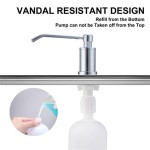Seat Cushions for Kitchen Chairs: Comfort and Style
Kitchen chairs, often selected for their durability and ease of cleaning, can sometimes lack the comfort needed for extended periods of sitting. This is where seat cushions become a valuable addition. They not only enhance the comfort level of the chairs but also contribute to the overall aesthetic of the kitchen. The selection of kitchen chair seat cushions involves considering various factors like material, size, shape, style, and ease of maintenance, each contributing to the final outcome of comfort and visual appeal.
The kitchen serves as a central hub in many households, a place for meals, conversations, and sometimes even work. Therefore, the seating arrangements within this space should be conducive to these activities. Hard, unyielding chair surfaces can lead to discomfort and fatigue, making prolonged seating less enjoyable. Seat cushions provide a layer of padding and support, distributing weight more evenly and alleviating pressure points. This leads to greater comfort during meals, while working at the kitchen table, or while simply relaxing.
Beyond comfort, seat cushions present an opportunity to elevate the kitchen's décor. They offer a relatively inexpensive and easily changeable way to introduce color, texture, and pattern into the space. A well-chosen seat cushion can complement the existing kitchen design or even serve as a focal point, adding personality and visual interest. The range of available styles, from modern minimalist designs to more traditional patterns, ensures that there is a seat cushion to suit every taste and kitchen aesthetic.
Key Considerations When Choosing Seat Cushions
Selecting the right seat cushions for kitchen chairs involves several important considerations. These include the material of the cushion, its size and shape in relation to the chairs, and the overall style and design. Failing to consider these factors can lead to discomfort, an ill-fitting cushion, or a clash with the existing kitchen decor.
Material Selection: The material of a seat cushion significantly impacts its comfort, durability, and ease of maintenance. Common materials include cotton, linen, polyester, and memory foam, each with distinct advantages and disadvantages. Cotton and linen are natural fibers that offer breathability and a soft feel. However, they may be less resistant to stains and wear compared to synthetic materials. Polyester is a durable and stain-resistant option, making it suitable for kitchens where spills are common. Memory foam provides excellent support and conforms to the body's shape, but can be more expensive and may retain heat. The filling of the cushion also plays a significant role. Foam, fiberfill, and down are common fillings. Foam provides firm support, while fiberfill offers a softer, more plush feel. Down is luxurious but requires more maintenance and may not be suitable for those with allergies.
The choice of material should align with individual priorities. If easy maintenance and stain resistance are paramount, polyester or a blend of synthetic fibers may be the best choice. For those prioritizing comfort and breathability, cotton or linen could be more suitable. It is beneficial to look for cushions with removable, washable covers to extend their lifespan and maintain hygiene.
Size and Shape: Accurate measurements of the kitchen chairs are essential before purchasing seat cushions. The cushion should fit snugly on the chair without overhanging or being too small. An ill-fitting cushion can be uncomfortable and visually unappealing. Square, round, and rectangular are common shapes. The shape of the cushion should complement the shape of the chair seat. For example, a square cushion is typically best suited for a square chair seat, while a round cushion complements a round chair seat. Attention should be paid to the thickness of the cushion as well. A cushion that is too thick may make it difficult to sit comfortably at the table, while a cushion that is too thin may not provide adequate support.
Consider the overall profile of the chair and the desired level of support when determining the appropriate thickness. For chairs with a low back, a thicker cushion may be preferable to provide more lumbar support. For chairs with a higher back, a thinner cushion may be sufficient. It's recommended to measure both the width and depth of the chair seat to ensure a proper fit. Some manufacturers provide templates or guidelines to assist in selecting the correct size and shape.
Style and Design: Seat cushions offer an opportunity to enhance the kitchen's aesthetic. The style and design of the cushions should complement the existing decor, including the color scheme, furniture style, and overall ambiance. Solid colors are a versatile option that can easily blend with various kitchen styles. Patterns, such as stripes, florals, or geometric designs, can add visual interest and personality. Consider the existing color palette of the kitchen when selecting cushion colors. Neutral colors, such as beige, gray, or white, provide a classic and timeless look. Bold colors can add a pop of vibrancy and energy to the space. The texture of the cushion can also contribute to the overall design. Smooth fabrics, such as cotton or linen, create a clean and minimalist look, while textured fabrics, such as velvet or corduroy, add depth and warmth. The use of decorative elements, such as piping, buttons, or ties, can further enhance the visual appeal of the cushions.
Consider the overall design style of the kitchen when selecting seat cushions. For example, a modern kitchen may benefit from cushions with clean lines and minimalist designs, while a traditional kitchen may be better suited for cushions with more ornate patterns and details. It is beneficial to gather inspiration from home decor magazines or online resources to visualize different cushion styles in a kitchen setting. Remember that the goal is to create a cohesive and visually appealing space that reflects individual preferences.
Types of Seat Cushion Attachment Methods
The method of attaching seat cushions to kitchen chairs affects their stability and ease of use. Common attachment methods include ties, non-slip backing, and hook-and-loop fasteners. Each method offers advantages and disadvantages in terms of security, convenience, and aesthetics.
Ties: Ties are a traditional and versatile method for securing seat cushions. They typically consist of fabric straps that are sewn onto the corners or sides of the cushion. The ties are then wrapped around the chair back or seat and tied in a knot or bow. Ties offer a secure and adjustable fit, allowing the cushion to be tightened or loosened as needed. They also add a decorative touch to the chair, especially when tied in a decorative bow. However, ties can sometimes come undone, requiring frequent re-tying. They can also be less convenient to use compared to other attachment methods, especially for individuals with limited dexterity.
When using ties, ensure that they are long enough to comfortably wrap around the chair and tie securely. Consider the color and material of the ties to complement the cushion and chair. Some cushions feature elasticized ties, which provide a more flexible and secure fit. It is helpful to routinely check the ties for wear and tear and replace them as needed to maintain the cushion's stability.
Non-Slip Backing: Non-slip backing is a convenient and discreet method for keeping seat cushions in place. This type of backing is typically made of rubber or silicone and is applied to the underside of the cushion. The non-slip material creates friction between the cushion and the chair seat, preventing the cushion from sliding or shifting. Non-slip backing is easy to use and requires no additional hardware or fasteners. However, it may not be as secure as ties or hook-and-loop fasteners, especially on chairs with smooth or slippery surfaces. The effectiveness of non-slip backing can also diminish over time as the material wears down or becomes dirty.
To maximize the effectiveness of non-slip backing, ensure that the chair seat is clean and dry before placing the cushion. Regularly clean the non-slip backing with a damp cloth to remove any dirt or debris. Consider adding a thin layer of non-slip fabric under the cushion for added security. For chairs with exceptionally smooth surfaces, it may be necessary to use an additional attachment method, such as ties or hook-and-loop fasteners, in conjunction with non-slip backing.
Hook-and-Loop Fasteners: Hook-and-loop fasteners, such as Velcro, provide a secure and adjustable attachment method for seat cushions. These fasteners consist of two strips: one with tiny hooks and the other with soft loops. One strip is attached to the underside of the cushion, and the other is attached to the chair seat. When the two strips are pressed together, the hooks and loops interlock, creating a strong and secure bond. Hook-and-loop fasteners are easy to use and allow for quick removal and reattachment of the cushion. They also provide a relatively clean and discreet appearance. However, hook-and-loop fasteners can sometimes lose their grip over time, especially with frequent use. The adhesive used to attach the fasteners to the cushion and chair can also weaken, causing the fasteners to peel off.
When using hook-and-loop fasteners, ensure that both surfaces are clean and dry before applying the adhesive. Use a strong adhesive specifically designed for fabric and wood. Position the fasteners carefully to ensure that the cushion is properly aligned on the chair. Regularly check the fasteners for wear and tear and replace them as needed. For added security, consider using screws or staples to reinforce the adhesive on the chair seat.
Maintenance and Care of Seat Cushions
Proper maintenance and care are essential for extending the lifespan and preserving the appearance of kitchen chair seat cushions. Regular cleaning, stain removal, and proper storage can help keep the cushions looking their best for years to come.
Regular Cleaning: Regular cleaning helps to remove dirt, dust, and spills that can accumulate on seat cushions. The frequency of cleaning depends on the level of use and the environment. In general, it is recommended to vacuum seat cushions at least once a week to remove loose dirt and debris. Use a brush attachment to reach crevices and seams. For cushions with removable covers, laundering is the most effective way to remove dirt and stains. Always follow the manufacturer's instructions for washing and drying. Some covers may require hand washing or dry cleaning. For cushions that cannot be laundered, spot cleaning is necessary. Use a mild detergent and a soft cloth to gently blot the affected area. Avoid rubbing or scrubbing, as this can damage the fabric. Allow the cleaned area to air dry completely before using the cushion.
Consider using a fabric protector spray to help prevent stains and spills from penetrating the fabric. This is especially helpful for cushions made of light-colored fabrics. Regularly check the cushions for signs of wear and tear, such as loose seams or frayed edges. Repair any damage promptly to prevent it from worsening.
Stain Removal: Spills and stains are inevitable in the kitchen. Addressing stains promptly is crucial to preventing them from becoming permanent. The type of stain and the fabric of the cushion will determine the best method for removal. For liquid spills, blot the area immediately with a clean, absorbent cloth. Avoid rubbing, as this can spread the stain. For solid spills, gently scrape off any excess material before blotting the area. For oil-based stains, sprinkle cornstarch or baking soda on the affected area to absorb the oil. Allow the powder to sit for several hours before vacuuming it up. For stubborn stains, consider using a commercial stain remover specifically designed for the fabric of the cushion. Always test the stain remover on an inconspicuous area of the cushion first to ensure that it does not damage or discolor the fabric. Follow the manufacturer's instructions carefully when using a stain remover.
For natural fiber cushions, such as cotton or linen, baking soda paste can be used to remove stains. Mix baking soda with water to form a thick paste and apply it to the stain. Allow the paste to dry completely before vacuuming it up. For synthetic fiber cushions, a mixture of vinegar and water can be used to remove stains. Mix equal parts vinegar and water and apply it to the stain with a clean cloth. Blot the area until the stain is removed. Rinse the area with clean water and allow it to air dry.
Proper Storage: Proper storage is essential for protecting seat cushions when they are not in use. When storing cushions for an extended period, clean them thoroughly to remove any dirt or stains. This will prevent the stains from setting and make them easier to remove later. Store the cleaned cushions in a dry, well-ventilated area. Avoid storing them in damp or humid environments, as this can lead to mold and mildew growth. If possible, store the cushions in a storage bag or container to protect them from dust and pests. Avoid stacking heavy items on top of the cushions, as this can compress the filling and damage the fabric. Periodically check the stored cushions for signs of damage or discoloration. Air them out regularly to prevent mustiness.
If space is limited, consider storing the cushions in vacuum-sealed bags to reduce their volume. This will help to save space and protect the cushions from dust and pests. When removing the cushions from storage, allow them to air out for several hours to restore their shape and fluff the filling. Following these maintenance and care tips can help to extend the lifespan of kitchen chair seat cushions and keep them looking their best for years to come.

Memory Foam Chair Cushion Great For Dining Kitchen And Desk Chairs Machine Washable Pad With Ties Nonslip Backing By Lavish Home Navy

Seat Cushions With Ties Quilted Chair Cushion Dining Garden Kitchen Pad Ebay

Ovzne Memory Foam Chair Cushions Comfortable Pads For Dining Room Kitchen Table Office Chairs Stay In Place Backing Microfiber Seat

Memory Foam Chair Cushion Machine Washable Pad With Nonslip Back For Dining Room Kitchen Outdoor Patio And Desk Chairs By Lavish Home Charcoal

Solid Chair Pad Super Soft Thick Washable Square Seat Cushion Cushions Pads For Kitchen Dining Office Room 15

Seat Pad Dining Room Garden Kitchen Chair Cushions Tie On Plain Seller Ebay

Chair Cushions With Rounded Back 18 Double Ties Anderson Buffalo Check Fabric Farmhouse Kitchen Pads Etsy

Lavish Home 69 05 B Memory Foam Chair Cushion For Dining Room Kitchen Outdoor Patio Desk Chairs Beige Zoro

Classic Sunbrella Dining Chair Cushion

Chair Cushion Floral Pad Square Round Kitchen Seat Cover Dining Cushions Tufted Quilted Etsy








